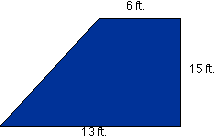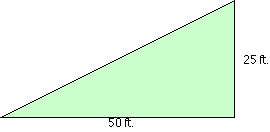

(Level 1) Answers
- What is the area
of the Wright Brother's rectangular planform?

- Step
1: base
= 6 ft.; height = 40 ft.
Step 2: area of rectangle = b x h = 240 ft.2
- What is the area
of the F-18 (Blue Angels) trapezoidal planform?

Step 1: height = 15 ft.; base 1 = 13 ft.; base 2 = 6 ft.
Step 2: area of trapezoid = ( h / 2 )( b1 + b2 ) = 142.5 ft.2
- What is the area
of the Concorde triangular planform? (Note: These are not the
actual dimensions.)

- Step
1: base
= 50 ft.; height = 25 ft.
Step 2: area of triangle = ( 1 / 2 ) x b x h = 625 ft.2
- What is the area
of the Space Shuttle's compound planform? (Note: These are not
the actual dimensions.)

Step 1: Divide the shape into three regions. From left to right, they are a triangle, trapezoid, and rectangle.
Step 2: Region 1: base = 13 ft.; height = 7.5 ft. (Calculate the area of this triangle.)
- Region
2: height = 18 ft.; base1 = 31 ft.; base2
= 7.5 ft. (Calculate the area of this trapezoid.)
Region 3: base = 9 ft; height = 31 ft (Calculate the area of this rectangle.)
Step 3: Add the areas of the three regions. Total area = 674.3 ft.2
- Region
2: height = 18 ft.; base1 = 31 ft.; base2
= 7.5 ft. (Calculate the area of this trapezoid.)
- What is the area
of the Boeing 747 trapezoidal planform? (Note: These are not
the actual dimensions. The trapezoidal planform cannot be divided into
two right triangles. Hint: Divide the figure into two scalene
triangles and compute their areas.)

Step 1: Divide the shape into three regions. From left to right, they are a triangle, rectangle, and triangle.
The height of the first triangle is a straight line drawn down from the upper left-hand corner of the shape.
The height of the second triangle is a straight line drawn up from the bottom right-hand corner of the shape.
Step 2: Region 1: base = 50 ft. , height = 77 ft. (Calculate the area of this triangle.)
Region 2: base = 6 ft. , height = 77 ft. (Calculate the area of this rectangle.)
Region 3: base = 19 ft , height = 77 ft (Calculate the area of this triangle.)
Step 3: Add the areas of the three regions. Total area = 3118.5 ft.2
- Which of the wings
has the largest area?
Boeing 747
- Which of the wings
has the smallest area?
F18
- Design your own
wing including its dimensions.
Answers will vary.
- What is the area
of your airplane's planform?
Answers will vary.
- Explain why you
designed your planform the way you did.
Answers will vary.
- List the wing types
in order from the largest area to the smallest, including your own wing
design.
Answers will vary
EDUCATOR RESOURCES | AERONAUTIC EDUCATIONAL RESOURCES | INTERNET ACCESS RESEARCH | ICING RESEARCH TUNNEL
BEGINNER'S GUIDE TO AERONAUTICS | FREE SOFTWARE | AERODYNAMICS INFORMATION | AERODYNAMICS PROBLEMS | PROPULSION INFORMATION |
PROPULSION PROBLEMS | FOILSIM INFORMATION | FOILSIM PROBLEMS | ENGINESIM INFORMATION | ENGINESIM PROBLEMS | ROCKETMODELER
AERONAUTICS LESSONS & ACTIVITIES | WIND TUNNEL WEB PAGES | AERONAUTS 2000 | VIDEOCONFERENCES WITH THE U.K.
Curator: Tom.Benson@grc.nasa.gov
Responsible Official: Kathy.Zona@grc.nasa.gov